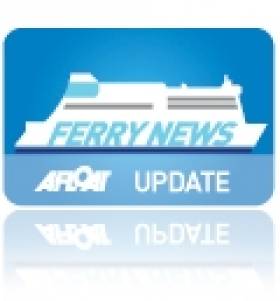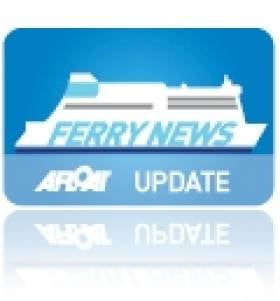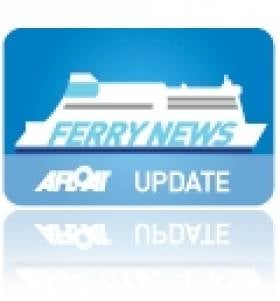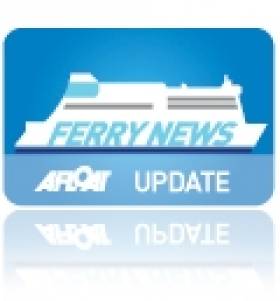Displaying items by tag: Stena Superfast
A North Channel ferry operated by Stena Line caught fire when berthed in Belfast Harbour yesterday, 19 July.
The Stena Superfast VII which was berthed at Victoria Terminal 4 (VT4) is where emergency crews from the Northern Ireland Fire and Rescue service were scrambled in the morning to the quayside on the West Bank Road.
According to the ferry operator, a small fire had broken out on a backup generator on the Stena Superfast VII. During the incident there were no passengers on board the ferry that operates the Belfast-Cairnryan route.
As ITV News reported, it is thought the fire will cause delays to the day’s sailings (which Afloat adds led to cancelled sailings instead, see further update below).
“Stena Line can confirm that a small fire broke out in an emergency generator room onboard the Stena Superfast VII vessel this morning (July 19th) as it prepared to sail for the 11.30hrs crossing from Belfast Harbour to Cairnryan," a spokesperson said.
"The fire was quickly extinguished by Stena Line crew, emergency services were alerted as a precaution. There were no passengers onboard the ship at the time and there were no injuries.
“The 11.30hrs sailing was cancelled and Stena Line is currently working on a revised sailing schedule for the remainder of the day and will advise all affected passengers accordingly.”
Afloat adds that Stena Line today, Thursday, 20 July, have a temporary replacement ferry in place as the Stena Nordica has taken over the sailing roster of Stena Superfast VII which went for repairs to the nearby Harland & Wolff shipyard.
The Stena Nordica yesterday evening was taken off service on the Rosslare-Fishguard as Afloat tracked the ropax less than a hour after departing the Wexford ferryport at 20.00. The 450 passenger ferry with 1,700 freight vehicle lane-metre capacity, made an overnight repositioning passage to Belfast Harbour to where it was redeployed on the route to Scotland.
As of this morning, Stena Nordica which is a more freight orientated ferry (ropax) made a first sailing this morning bound for Cairnryan. The routine scheduled 07.30 sailing instead took place slightly later with a departure of 08.00hrs. The return sailing from Cairnryan is scheduled for 11.30 with an arrival back in Belfast at 13.45.
According to the Stena Line freight website, the Stena Superfast VII is to remain out of service until next Sunday, 23 July.
In the meantime, the North Channel ferry's twin, Stena Superfast VIII will maintain sailings on the route along with the Stena Nordica on the busy N.Ireland-Scotland short sea link.
It is less than a week ago when the Stena Nordica had only been introduced on the Rosslare-Fishguard route to replace the veteran Stena Europe as the new permanent ferry on the Ireland-Wales route.
Passengers on the St. Georges Channel route have been advised of alternative travel arrangements which have been made with Irish Ferries on their Rosslare-Pembroke Dock route.
‘Superfast’ Sails into Holyhead In Advance of Dublin Port Route Launch
#StenaSuperfast - Stena Superfast X, which is due to make her debut on the Dublin-Holyhead route next week arrived in the Welsh port yesterday, writes Jehan Ashmore.
Her first call to the north Wales port follows a delivery voyage from Gdynia in Poland where she underwent an extensive refit.
Under command of Captain Richard Davies, Stena Line's 30,551 tonnes newcomer arrived at her homeport on Anglesey. It is understood initial berthing trials were made at the jetty.
Stena Superfast X has a capacity for 1,200 passengers and almost 2kms of space for cars and freight vehicles. The 204m long vessel had sailed from the shipyard in Gdynia where work to upgrade passenger facilities and reconfigure vehicle decks were carried out on the 10-deck ferry.
The re-modelling of passenger decks "will be a hint of Scandinavian design" commented Ian Davies, Stena Line Irish Sea Route Manager (South) during a recent interview on BBC Radio Wales.
Among the facilities are free cinema's, catering for adults and for children, while the family lounge will feature X-Box stations for further entertainment. In addition to a premium plus lounge and for freight customers there is a dedicated trucker's lounge.
Launch of the Superfast X next week on the core central Irish Sea route follows the company's decision to withdraw the HSS fast-ferry service on the Dun Laoghaire-Holyhead route. Instead, Stena are to concentrate all existing operations from Dublin Port on the Ireland-Wales link.
The Stena Superfast X will make two round-trips daily, taking 3 hours 15 minutes and will operate alongside Stena Adventurer. The new ferry replaces the smaller Stena Nordica on the route which as previously reported on Afloat.ie, is heading for a new career on the Straits of Dover.
Stena’s New Dublin-Holyhead ‘Superfast’ Ferry On Delivery Voyage
#StenaSuperfast – Stena Line's latest flagship, Stena Superfast X which is to make her debut on the Dublin-Holyhead route next month is on her delivery voyage to the Irish Sea, writes Jehan Ashmore.
According to her master, Captain Richard Davies said "It is great to be back at sea and looking forward to bringing this magnificent vessel to her new home on the Irish Sea."
The 30,000 tonnes newcomer is currently off Scotland's west coast having sailed across the North Sea and passed offshore of John O'Groats at teatime yesterday. She had departed from Gdynia, Poland after an extensive refit to enhance levels of facilities for her 1,200 passengers.
Introduction of Superfast X will raise the bar on the core Irish Sea route also operated by close rivals Irish Ferries with the Ulysses, Epsilon and fast-ferry Jonathan Swift.
Stena Superfast X is to make her first call to her new homeport of Holyhead and is understood to be tomorrow around dawn. At a later stage she will visit Dublin Port for further berthing trials before entering service alongside Stena Adventurer.
The decision by Stena to concentrate all operations in Dublin Port follows the company's announcement earlier this month to axe the loss making Dun Laoghaire-Holyhead route. The historic link had been served by the Stena HSS high speed sea-service craft, Stena Explorer which began service in 1995.
The debut of Superfast X on the Dublin route will see the ferry boast 10 decks. Among the fitted-out facilities on her passenger decks are a premium lounge, several dining options, a cinema and in the family lounge, X-Box stations for entertainment.
She also has almost 2 kilometres of lane space for vehicles and freight traffic on the core central corridor route. Freight drivers will have their own dedicated lounge.
The newcomer follows a pair of Superfast sisters VII and VIII which also transformed services when Stena launched in 2011 a new route between Belfast and Cairnryan.
Second Year of Stena Line Superfast Service
#BelfastCairnryan – Today Stena Line marks the second anniversary in opening the Belfast-Cairnryan route.
The £200m investment in new port facilities and a pair of Superfast sisters have proven to be very popular with tourist and freight customers.
The introduction of Stena Superfast VII and VIII from Scandinavia has significantly raised the standard of ferry services between Northern Ireland and Scotland.
Since the start of the new service in 2011 Stena Line has achieved some impressive performance statistics including carrying 2.2m passengers, almost 500,000 cars and over 300,000 freight units.
Paul Grant, Stena Line's Route Manager for Irish Sea North said: "When we opened up the new Belfast-Cairnryan we were confident that the new route would prove popular with our freight and travel customers. The combination of a high quality service and good value fares has proven to be successful.
Stena Superfast VII Departs Poland for New Belfast-Cairnryan Route

The New Superfast leaves Gdansk
The 30,285grt newcomer and her sister Stena Superfast VIII will become the largest ever ferries running on the North Channel , though prior to entering service on 21 November, they will undertake berthing trials and crew training.
For the next two-years the sisters are on charter from Scandinavian operators Tallink, and are to operate the new 2 hour 15 minute route with 12 crossings daily. The ten-deck ships can carry up to 1200 passengers, 660 cars or 110 freight units. The sisters will be re-gistered in their new homport of Belfast.
The relocation of Scottish ferry port and the introduction of the Superfast sisters will replace the existing pair of conventional ferry tonnage, Stena Caledonia and Stena Navigator (1984/15,229gt) the latter vessel is believed to be sold. In addition HSS sailings will cease causing the HSS Stena Voyager to become redundant, she was the second of the trio of pioneering HSS 1500 craft built.
When Stena Superfast VII departed Gdansk, she passed the Stena Vision which operates Stena Line's Karlskrona-Gdynia route, the Baltic Sea city lies to the west of Gdansk. Also in Gdansk was the Stena Feronia, the former Irish Sea serving Visentini built ro-pax Dublin Seaways, which was operated albeit briefly by DFDS Seaways last year on the Dublin-(Birkenhead) Liverpool service.
She served under her new Scandinavian owners but the firm's first foray into the Irish market lasted a mere six months. DFDS Seaways sold their Irish Sea network to Stena Line (to read report click HERE) with the exception of their Dublin-Birkenhead service which closed. In addition the Dublin-Heysham freight-only route which closed until re-opened by Seatruck Ferries. The route is currently served by Anglia Seaways, the freightferry which DFDS previously used on the route is on charter to the operator.
- DFDS Seaways
- Baltic Sea
- Stena Line
- Ports and Shipping News
- Seatruck Ferries
- North Channel
- Stranraer
- Dublin Seaways
- Ferry news
- Tallink
- Loch Ryan Port
- HSS Stena Voyager
- Stena Caledonia
- Stena Navigator
- Belfast Lough News
- HSS
- Visentini ropax
- BelfastCairnryan
- Stena Superfast VII
- Stena Superfast VIII
- Stena Superfast
- Superfast Sisters
- North Channel ferry routes
- Stena Feronia
- LRP
- BirkenheadBelfast
- DublinBirkenhead



























































